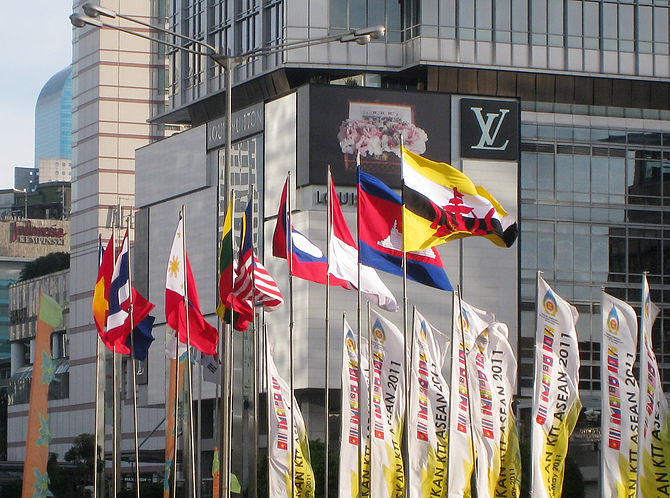
Emmanuel Mongaya
Columnist, Sun.Star Cebu & Superbalita
Digital Media Manager, PRworksph.com
“Great strategy, like great works of art or great scientific discoveries, call
for technical mastery in the working out but originate in insights that are beyond
the reach of conscious analysis.” Kenichi Ohmae, The Mind of the Strategist
![]() Many Filipino entrepreneurs, like our basketball icons, display a “never-say-die” attitude even during crunch time in the game we call business. Never mind if our neighbors — the other nine members of the Association of Southeast Asian Nations or ASEAN — have long prepared right after the 2007 ASEAN Summit in Cebu, Philippines.
Many Filipino entrepreneurs, like our basketball icons, display a “never-say-die” attitude even during crunch time in the game we call business. Never mind if our neighbors — the other nine members of the Association of Southeast Asian Nations or ASEAN — have long prepared right after the 2007 ASEAN Summit in Cebu, Philippines.
For Filipinos, the year 2014 is not too late to prepare for the ASEAN Economic Community or AEC that formally begins on December, 2015.
During the recent Sun.Star Economic Forum that gathered captains of the different industries in Central Visayas, Philippine officials led by Trade Secretary Greg Domingo urged drawing up and refining industry roadmaps. Small entrepreneurs are encouraged to avail of the services offered by the Department of Trade and Industry (DTI) to better understand the ASEAN Economic Community and how one can deal with the challenges and take advantage of the opportunities.
Meanwhile, one can also start looking into the following 6 Cs as a start in mapping your ASEAN 2015 strategy:
1. Customers
Ordinary consumers care more about a product’s quality, design, price, and appeal. They don’t think about the impact on trade deficits nor employment figures in determining what we want to buy. It does not matter that the coffee sachet at the neighborhood sari-sari store is a foreign brand. Nor do they worry that the branded bag the wife covets is actually made in Cebu.
What matters more perhaps are what people within their social networks say about a product or brand and what they learn after they Google. Information has empowered the consumers.
2. Competition
Three scenarios face Filipino entrepreneurs. One, the entry into the country of ASEAN competitors. Two, ASEAN competitors wage stiff competition to prevent Filipino brands from winning in their own turf. Three, the possibility of forging strategic alliances with fellow ASEAN partners. The Department of Trade and Industry (DTI), during the Sun.Star Economic Forum in Cebu City, pushed for the clustering approach for SMEs.
3. Culture
A brand is a collective perception in the minds of consumers. Because this shared understanding is critical to a brand’s meaning, culture especially local culture becomes a key factor in determining the success of local champions or that of global brands penetrating local communities in integrated economies. The marketing and public relations strategy strategically consider local culture.
4. Company
To compete in an integrated ASEAN market, companies will need to find a way to deal with the cost. A strategy to do this is forging strategic partnerships to help them amortize their fixed costs — that includes, for instance, building and maintaining a brand name across different countries at the same time. Former Economic and Development Secretary Cielito Habito, who is now the Chief of Party of the US Assistance for International Development (USAID)’s Trade-Related Assistance for Development (Trade) stressed during the Sun.Star Economic Forum the need to share production processes and looking at the whole economic community as an integrated production line.
5. Currency
An ASEAN strategy inevitably must consider the volatile exchange rates. One strategy here is to neutralize the impact of currency. In his book “The Borderless World,” Kiniche Ohmae wrote: “International companies have tried to neutralize the impact of currency by essentially matching costs to revenue and by becoming strong in all regions … so that if one is negative, the others are positive. Companies have taken these steps in addition to traditional measures of moving into low-cost countries, polishing their techniques of international finance (for example, hedging, netting, options) and automation.”
6. Country
One’s AEC strategy might consider the possibility of moving deeper into countries to neutralize the impact of currency and possible protectionism or to take advantage of the bigger market or cheaper labor. One Cebu businessman, for instance, considered transferring the base of his furniture manufacturing business to Jakarta, Indonesia. Or it could mean looking for a local champion in the target country that could serve as your strategic partner. At the same time, entering another country involves serving different customer segments differentiated by different cultures and religions.
Related Stories
AEC 2015: to be a player in one big economy (Sun.Star Weekend Davao)
Information, roadmaps on ASEAN 2015 sought
10 trends to watch Cebu
Beyond ASEAN 2015
Are we ready? ASEAN 2015 documents and other resources






Pingback: Philippine startups: Leveraging opportunities of ASEAN 2015 | PRworks Online